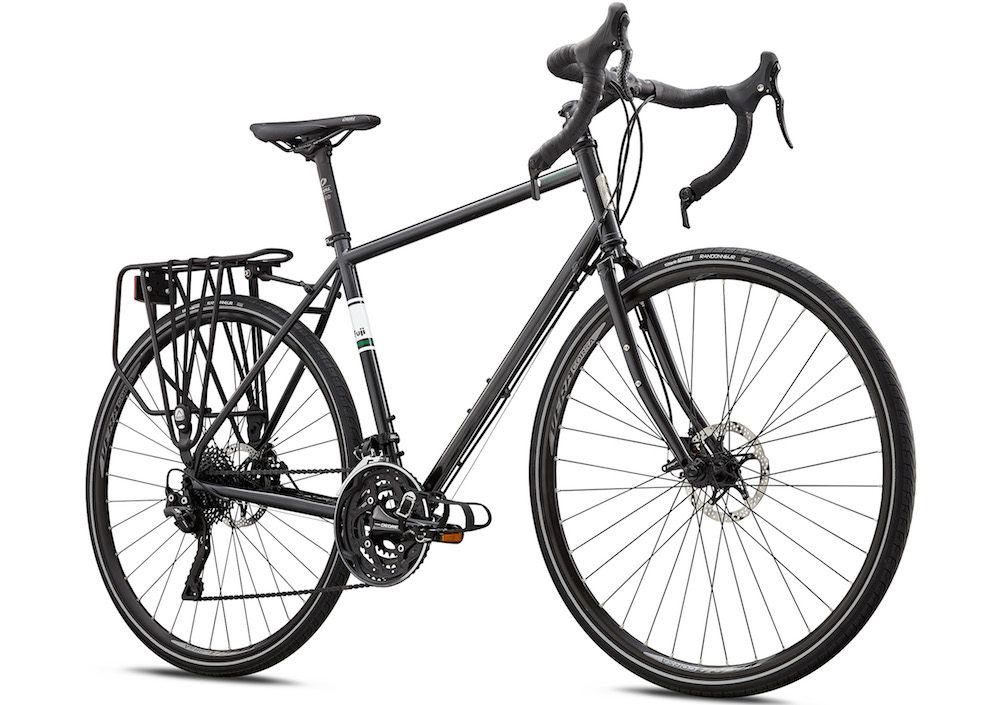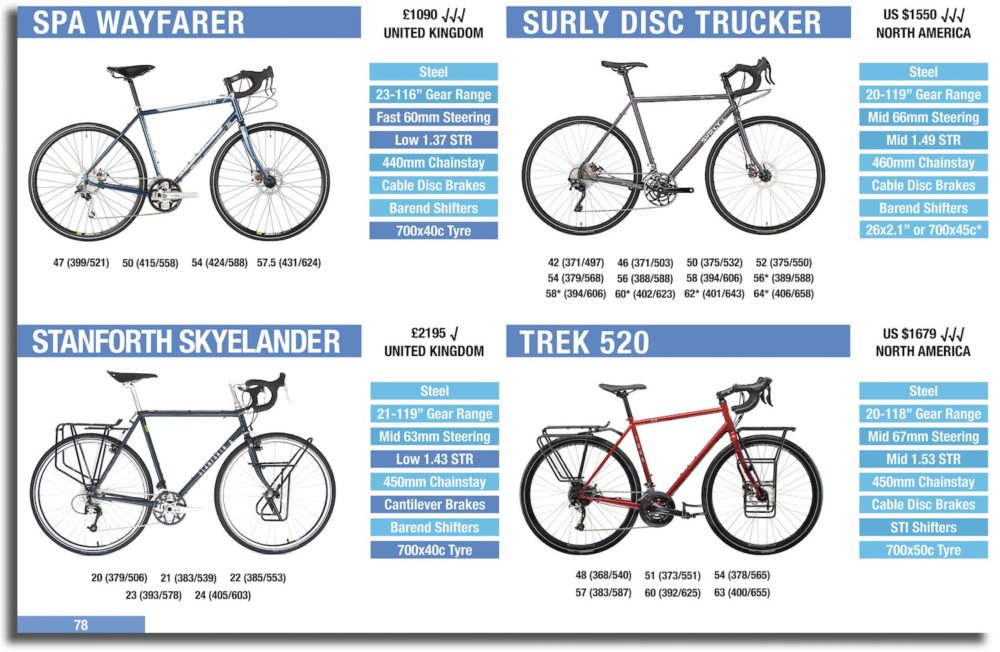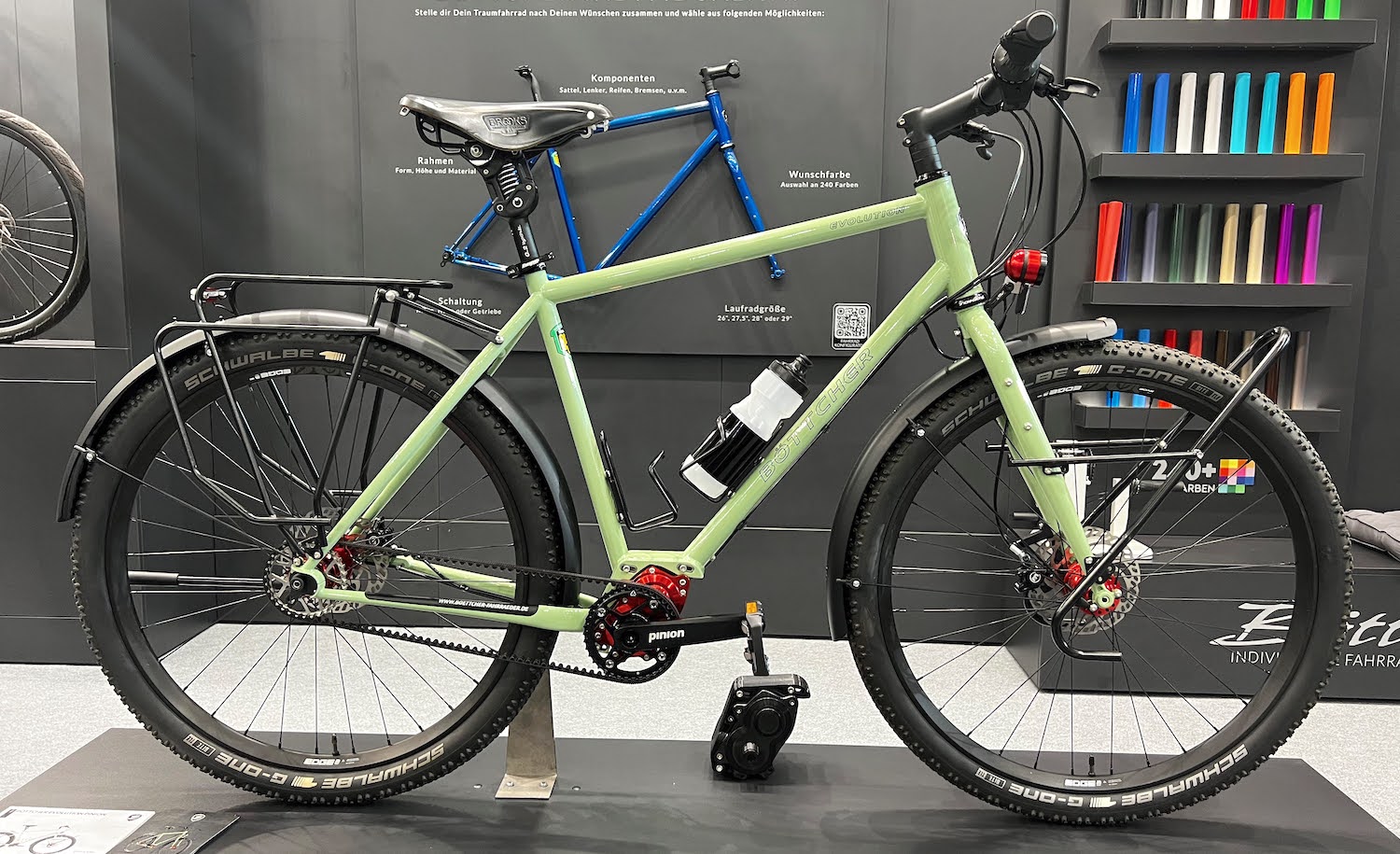Table of Contents
Not only has the entry-level Fuji Touring had a big revamp, but a new premium disc brake model enters the range. While the base model is designed to offer that bargain price point, the 2018 Fuji Touring Disc is ready to compete with the more renowned touring bike models.
Fuji have stuck with a steel frame and fork for their top model, most notably modifying the frame to accommodate disc brakes. But the 2018 Fuji Touring Disc is not just about adding disc brakes, it has some nice high-end touring parts throughout.
Let’s take a closer look.
The 2018 Fuji Touring Disc

With a US $1299 sticker price, the 2018 Fuji Touring Disc is pitched against some of the best touring bikes in the game, namely the Marin Four Corners (US $1039), Specialized AWOL (US $1200), Trek 520 (US $1359), Surly Disc Trucker (US $1449) and Kona Sutra (US $1499).
The all-new steel frameset is available in seven sizes and should accommodate most. It has a revised geometry which incorporates a long wheelbase, slack head angle, and big fork rake, making the bike great for those long days in the saddle. The frame has three bidon mounts in and around the front triangle, and the fork can fit cargo cages or a front pannier rack. The bike is, of course, ready for you to fit up some decent fenders too.
The 2018 Fuji Touring Disc is using a Shimano 10-speed drivetrain which is matched to a set of barend shifters. The Shimano Deore touring crankset has both big rings for the flat as well as a small 26t ring for the hills. Up the back is a Shimano XT touring-specific derailleur (T-8000) and a big 11-36t rear cassette. This brings the lowest gear on the bike to a shade under 20 gear inches, resulting in the Fuji Touring Disc having one of the smallest climbing gears on any touring bike.
The tyres are a model called the Vittoria Randonneur. These are some of the most puncture-resistant tyres available but have also been tested to be one of the slowest rolling. If you wanted a bit of free speed, take a look at switching them out to the Schwalbe Almotions. Not only will you go faster with the same energy, but you’ll be able to go wider too.
The brakes can’t get any better for touring. They’re cable-operated disc brakes by TRP which are super easy to maintain, allowing you to lubricate and swap out the brake cables with ease. The TRP Spyre calipers offer tonnes of power too – while almost all cable disc brakes stop using one piston, the Spyres pull both pistons in to give that hydraulic brake feel. Fuji have opted for the new flat-mount caliper standard, which future-proofs the bike more than others and looks pretty neat.
As the disc brakes come with a bit of a weight penalty, the 2018 Fuji Touring Disc weighs 13.46kg (29.6lbs) according to the spec sheet, adding just 380g (0.8lbs) over the base model. This is a worthwhile exercise as disc brakes are unrivaled when it comes to cycling in the hills. That said, the biggest advantage to disc brake is in wet conditions when they can slow the bike down as if it’s dry.
Want To Compare This Touring Bike With Dozens of Others?
Check out The Touring Bicycle Buyer’s Guide which compares touring bike steering, sizing, gear ratios, specification, pricing and more. The Bikepacking Bike Buyer’s Guide does the same thing, however, with a focus on lighter bikes and models with more off-road capability. Both of these guides are updated annually with the latest models at no extra cost!
Helpful Resources
All About Touring Bike Brakes
Frame Materials for Bicycle Touring
How to Select Touring Bike Gearing
Understand Bicycle Frame Geometry
What’s the Difference between Cyclocross and Touring Bikes?
Touring & Bikepacking Bike Overview
2016 Advocate Lorax
2018 All City Gorilla Monsoon
2016 Basso Ulisse
2016 Bianchi Volpe and Lupo 2016
2016 Bombtrack Beyond
2017 Bombtrack Beyond
2018 Bombtrack Beyond
2018 Bombtrack Arise Tour
2019 Bombtrack Beyond
2016 Brodie Elan Vital
2016 Cannondale Touring
2019 Cannondale Topstone
2020 Cannondale Topstone
2016 Cinelli Hobootleg Geo
2018 Co-Op ADV 4.2
2017 Curve Grovel V2
2017 Diamondback Haanjo EXP Carbon
2016 Fuji Touring
2017 Fuji Touring
2018 Fuji Touring
2018 Fuji Touring Disc
2016 Genesis Tour de Fer
2016 Giant ToughRoad
2017 Giant ToughRoad
2018 Giant ToughRoad and ToughRoad GX
2016 Jamis Aurora and Aurora Elite
2019 Jones Plus SWB
2020 KOGA WorldTraveller-S
2016 Kona Big Rove
2016 Kona Roadhouse and Sutra LTD
2016 Kona Sutra
2017 Kona Sutra
2018 Kona Sutra
2018 Kona Sutra LTD
2019 Kona Sutra and Sutra LTD
2020 Kona Sutra and Sutra LTD
2020 Kona Unit X
2016 Marin Four Corners
2017 Marin Four Corners
2018 Marin Four Corners
2016 Masi Giramondo
2018 Masi Giramondo
2016 Niner RLT9
2016 Rawland Ulv and Ravn
2016 Salsa Deadwood
2017 Salsa Fargo
2018 Salsa Fargo Ti Frameset
2018 Salsa Journeyman
2016 Salsa Marrakesh
2017 Salsa Marrakesh
2018 Salsa Marrakesh
2020 Salsa Marrakesh
2017 Salsa Vaya
2019 Salsa Warbird
2016 Specialized AWOL
2017 Specialized AWOL
2017 Specialized Diverge
2018 Specialized Diverge
2019 Specialized Diverge
2017 Specialized Sequoia
2018 Specialized Sequoia
2019 Specialized Sequoia
2018 Surly Bridge Club
2017 Surly Troll
2016 Traitor Wander
2019 Trek 520
2016 Trek 920, 720, 520 & CrossRip
2017 Trek CrossRip
2018 Trek 920
2018 Trek 1120









Maybe a trivial question, but…. What is the purpose of using separate bar-end shifters?
Aren’t Tiagra’s integrated levers compatible with Deore XT’s 3×10 derailleurs?
PS
The bike is great anyway! 😉
The barend shifters are just a simple shifting system that are almost impossible to break.
Unfortunately, 10-speed Tiagra isn’t compatible because it uses a different cable-pull ratio. The best way to get around this is to use older 105, Ultegra or Dura Ace 10-speed shifters, and match it to an old 9-speed Shimano mountain bike derailleur. More information on this mod can be found on this page: https://www.cyclingabout.com/wider-gear-range-road-shifters-gears-for-easier-hill-climbing/
Hi Alee,
do you know the max tire size of the fuji touring disc?
Thank you for your great work, love your website!
Not 100% sure, but it’s likely about ~40mm rear and 45mm front. Slightly less with fenders.
It’s definitely a nice bike !
One question, though: the rims. It’s an unknown brand (Vera Terra). I’ve always wondered how good and durable they were. They look good, I can’t believe they would put sh…y wheels on a nicely specd bike.
Would you trust these wheels for a big and long trip, Alee ? That’s my question.
Fuji have used re-branded rims under the name Vera Terra for a while, and I haven’t heard a bad thing about them. Wheel strength is normally a function of even spoke tension, so get your spoke tension checked regularly and you probably won’t have issues.
Would love it if not for the only choice gray color and I really don’t like bar end shifters.
Hello, i have decided to buy the fuji touring…but i would really like to recieve an advice…v-brakes or disc brakes?…there is a difference of 360 dollars?…are disc brakes really necesary??…or for Long distance vbrakes are already ok??…any info is more than welcome….thanks a Lot….
Also heard that in Long distance trips vbrakes are more easily to be repaired or Either changed than disc brakes?….is this true??…thanks…
Both types of brakes are totally fine for touring. Disc brakes are powerful, very well proven, won’t wear out your wheels and will perform flawlessly in all weather conditions. I’ve used them on touring bikes in 50+ countries. I used v-brakes for 10 years before that, and people were using rim brakes for a century before me.
The $300 also gets you better quality derailleurs and an upgrade to 10-speed.
Thanks alee, understood that both brakes are Fine for touring,
But what about repairing and changing or whatever reffered on brakes on a really Long distance trip like maybe a round World trip…am i Going to get disc brakes easily like vbrakes?…what Could you say about the manteinance on both brakes…or what is the easiest option for a round World trip Where maybe it is not possible to Find many offers everywhere when talking about mantaining or changing brakes?
Thanks a Lot Again Alee and sorry for bothering you Again…
The only thing you will need to replace with cable disc brakes are the cables and brake pads. I normally do that every 10,000km or so, but in the mountains, the interval for brake pads can be as short as 1500km. I carry two sets always, and stock up on pads / change my brake cables in larger cities. I’ve always been able to source Shimano or Avid brake parts.